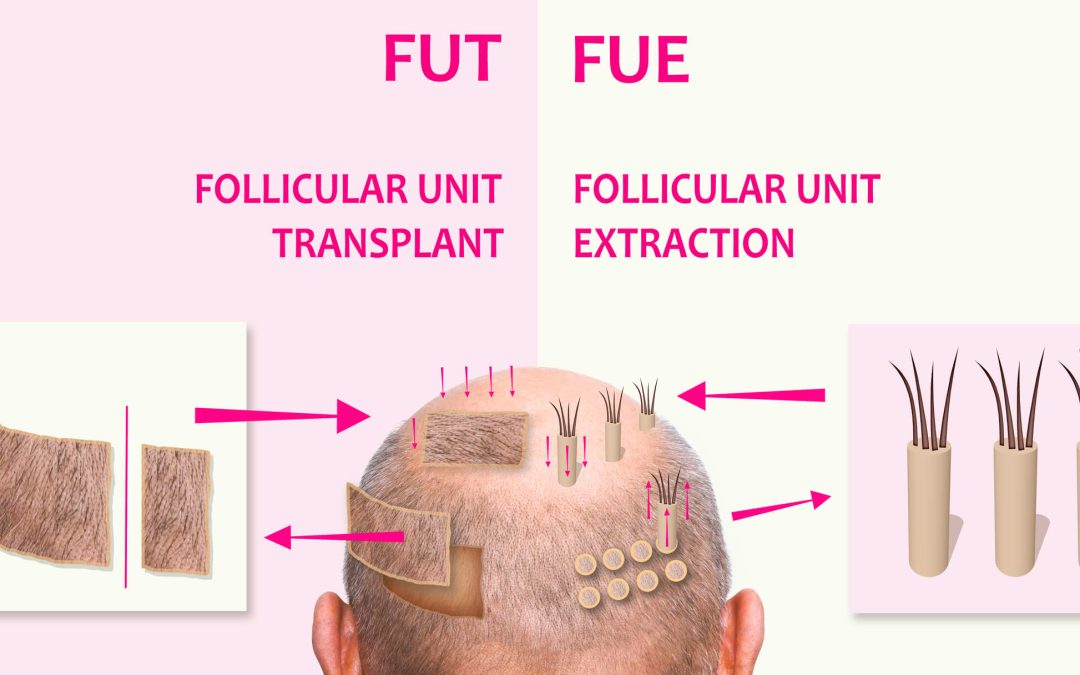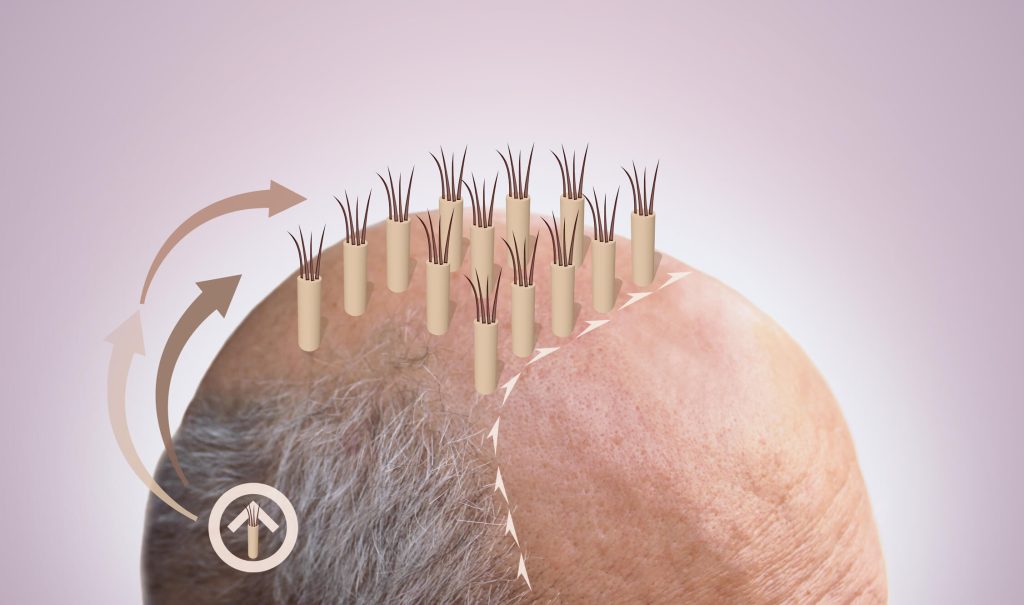Are you considering a hair transplant to restore your confidence and regain a full head of hair? If so, you’ve likely encountered FUE (Follicular Unit Extraction) and FUT (Follicular Unit Transplantation). These are two popular hair restoration methods, each with advantages and considerations. Deciding between the two can be challenging, but understanding the differences and benefits of each can help you make an informed decision. Let’s delve into the details of FUE vs FUT Hair Transplant to help you determine which approach is right for you.
FUE (Follicular Unit Extraction)
Follicular Unit Extraction (FUE) is an advanced, minimally invasive hair transplant surgery. It involves carefully taking individual hair follicles from the donor site, usually at the back or sides of the scalp. FUE procedures have gained popularity due to their ability to leave minimal scarring and allow for faster recovery times compared to FUT. Tiny circular cuts are made around each follicular unit using a unique punch tool. These follicles are then gently removed and transplanted into hair loss or thinning areas. FUE ensures natural results and is preferred by many for its precision. It’s an excellent option for those wanting a subtle yet successful FUE hair transplant procedure.
Advantages of FUE
The advantages of Follicular Unit Extraction (FUE) are manifold, making it a popular choice for individuals seeking hair transplantation. Here’s a closer look at some of the key benefits:
1. Minimally Invasive – FUE is less invasive than traditional hair transplant techniques like Follicular Unit Transplantation (FUT). This surgical procedure involves making tiny, circular incisions around each follicular unit, resulting in minimal trauma to the scalp tissue.
2. No Linear Scarring – Unlike FUT, which uses strip harvesting to leave a linear scar at the donor site, FUE leaves small, less noticeable scars, especially with short hairstyles. This makes it particularly appealing to those who prefer short or cropped haircuts.
3. Quick Recovery – The minimally invasive nature of FUE typically leads to a quicker recovery time than FUT. Patients experience less discomfort and downtime, allowing them to return to normal activities sooner.
4. Precision and Natural Results – FUE allows for precise extraction and transplantation of individual follicular units, enabling the surgeon to create a natural-looking hairline and overall aesthetic. The angle, direction, and density of transplanted hairs can be carefully controlled to achieve optimal results.
5. Suitable for Small-Scale Procedures – FUE is well-suited for small-scale procedures or touch-ups, making it ideal for patients who require a limited number of grafts or want to target specific areas of hair loss.
6. Preserves Donor Area – Since FUE involves harvesting follicles individually, it allows for selective extraction from the donor area, preserving the surrounding hair follicles and maintaining overall hair density in the donor region.
7. Versatility – FUE can be used to transplant hair on the scalp and in other areas of the body, such as the eyebrows, beard, or chest, providing solutions for various cosmetic concerns.
8. Minimal Discomfort – The local anesthesia administered during the FUE procedure ensures that patients experience minimal discomfort during the surgery. Post-operative pain and discomfort are also typically manageable with prescribed medications.
FUE hair transplants, known for their precision and ability to extract individual hair follicles without needing a linear scar, have gained immense popularity in recent years. Their advantages, including their minimally invasive nature, absence of linear scarring, quick recovery, precision in achieving natural results, versatility, and minimal discomfort, make them a preferred choice for many individuals seeking effective hair transplant solutions.
FUT (Follicular Unit Transplantation)
Follicular Unit Transplantation (FUT), also known as the strip method, is a common approach to FUT hair transplants. This hair transplant method is favored by many individuals experiencing pattern baldness. It entails harvesting a small strip of skin from the back of the head, where the hair is abundant. This strip is then dissected into individual follicular units, each containing varying amounts of hair follicles, typically ranging from one to four hairs. These units are meticulously transplanted into the recipient site, addressing the areas where hair loss has occurred. The primary difference between FUT and other hair transplant methods, such as FUE, lies in the harvesting technique and the amount of tissue removed from the donor area.
FUT is noted for its capacity to produce many hair grafts in a single session, resulting in increased hair density. FUT, also known as strip harvesting, entails removing a strip of scalp from the back of the head, which needs stitches to repair the incision, making it unsuitable for people who want to keep their hair short. Though it may leave a scar, advances in surgery procedures have reduced its visibility, resulting in natural-looking results for both men and women.
Advantages of FUT
The Follicular Unit Transplantation (FUT) technique offers several advantages that make it a preferred choice for some individuals seeking hair restoration:
1. High Graft Yield – FUT typically provides more hair grafts in a single session than other hair transplant procedures like FUE. This makes it ideal for individuals with extensive hair loss or those aiming for maximum hair density in one procedure.
2. Cost-Effectiveness – Since FUT often yields a greater number of grafts per session, it can be a more cost-effective option for patients seeking comprehensive hair restoration on a limited budget.
3. Efficiency – The FUT procedure is generally faster than other hair transplant techniques. This efficiency can benefit the patient and the surgical team, reducing overall procedure time and minimizing discomfort.
4. Long-Term Results – When performed by experienced surgeons, FUT can deliver long-lasting and natural-looking results. The harvested hair follicles are typically robust and healthy, leading to successful transplantation and sustainable hair growth.
5. Suitability for Specific Cases – FUT may be preferred for individuals with specific hair loss patterns or scalp conditions. The strip harvesting method allows for precise extraction of donor tissue, making it suitable for cases where many grafts are needed or when working with a limited donor area.
6. Technical Precision – FUT involves meticulous dissection and preparation of follicular units under magnification. This precision ensures that the transplanted grafts are carefully placed in the recipient area, contributing to a natural-looking hairline and overall aesthetic outcome.
7. Minimal Transection – Transection refers to the inadvertent damage or cutting of hair follicles during transplantation. With FUT, the harvested follicular units are often intact and less prone to transection, leading to higher graft survival rates and improved overall success of the procedure.
8. Experience and Expertise – FUT requires specialized skills and expertise on the part of the surgical team. Choosing a reputable clinic with experienced surgeons can significantly enhance the success and satisfaction of the FUT procedure.
While FUT may not be the right choice for everyone, its distinct advantages make it a valuable option for many individuals seeking effective and long-lasting hair transplant solutions. Consulting with a qualified hair transplant specialist can help determine whether FUT is the most suitable approach based on your unique needs and goals.
Choosing the Right Option
Selecting the ideal hair transplant procedure requires thorough consideration to ensure the best fit for your needs. Let’s delve deeper into the factors you should weigh:
1. Hair Loss Pattern Assessment – Understanding the extent and pattern of your hair loss is crucial. By analyzing whether your hair loss is localized or diffuse, you can determine which technique—FUE or FUT—will most effectively address your specific concerns. For instance, if you have limited donor hair or desire precise hairline restoration, the FUE technique might be the preferred choice due to its ability to extract individual follicles.
2. Desired Outcome Deliberation – Consider your aesthetic goals and expectations regarding the hair transplant’s final result. Do you aim for a natural-looking hairline with optimal density, or are you primarily focused on covering bald patches? Your desired outcome will influence the choice between FUE and FUT, as each technique offers unique advantages in achieving specific aesthetic objectives.
3. Scarring Tolerance Evaluation – Determine your degree of comfort with the potential scarring involved with FUE and FUT treatments. While FUE usually causes small scars to spread around the donor area, FUT leaves a linear scar along the donor strip’s extraction site. You may favor minimal scarring or maximum graft yield, depending on your tastes and lifestyle.
4. Budgetary Considerations – Factor in the cost of each hair transplant procedure and explore financing options to ensure alignment with your financial resources. While FUE may be more expensive due to its labor-intensive nature and advanced technology requirements, FUT could offer a cost-effective alternative, particularly for individuals requiring extensive grafting sessions.
Seeking guidance from a qualified Newport Beach hair restoration specialist is imperative to receive personalized recommendations tailored to your unique circumstances. A thorough consultation will allow the specialist to assess your hair loss pattern, discuss your aesthetic preferences, address any concerns regarding scarring, and provide transparent cost estimates. By prioritizing these factors and leveraging expert advice, you can confidently select the right hair transplant option and embark on your journey to hair restoration with clarity and assurance.
Consult with Neograft Hair Restoration Orange County Today!
At Neograft Hair Restoration Orange County, our expert surgeons specialize in Follicular Unit Extraction (FUE) and Follicular Unit Transplantation (FUT) procedures. We provide comprehensive information on “FUE vs FUT Hair Transplant” to help you decide on the best treatment for your needs.
We understand that everyone is different, and we are dedicated to crafting personalized treatment plans tailored to your specific objectives and concerns. Whether you opt for FUE or FUT, rest assured that our team is committed to delivering exceptional results with high success rates, ensuring natural-looking fullness and satisfaction.
Take the first step towards reclaiming your confidence and appearance by contacting us today at (949) 644-3592 to schedule a consultation. Explore your treatment options and embark on the path to a more confident, fuller you!
FAQs about FUE vs FUT Hair Transplant
1. What are FUE and FUT hair transplants?
Follicular Unit Extraction involves extracting hair follicles from a donor site and transplanting them to thinning areas, resulting in minimal scarring. FUT (Follicular Unit Transplantation) involves removing a strip of scalp to obtain multiple grafts, which are then transplanted to the recipient site.
2. What are the main advantages of FUE?
FUE offers several benefits, including minimal invasiveness, no linear scarring, quicker recovery times, and the ability to target specific areas precisely. It’s suitable for individuals preferring short hairstyles.
3. What are the key benefits of FUT?
FUT provides a higher graft yield per session, making it a cost-effective choice for extensive hair loss. It is efficient and can produce long-lasting, natural-looking results when performed by experienced surgeons.
4. How does the recovery process differ between FUE and FUT?
FUE typically allows for a faster recovery with less discomfort, while FUT may involve a more extended healing period due to the linear scar that requires stitches. However, both methods have manageable post-operative care.
5. Which method leaves less visible scarring?
FUE leaves small, circular scars that are often less noticeable, especially with shorter hairstyles. In contrast, FUT results in a linear scar, which may be more visible depending on the hairstyle.
6. Can both methods achieve natural-looking results?
Yes, both FUE and FUT can provide natural-looking results when performed by skilled surgeons. Choosing methods often depends on individual preferences, hair loss patterns, and desired outcomes.
7. Which technique is better for extensive hair loss?
FUT is generally preferred for extensive hair loss because it can yield more grafts in a single session. FUE may require multiple sessions for the same result.
8. What factors should I consider when choosing between FUE and FUT?
Consider your hair loss pattern, desired results, comfort with potential scarring, and budget. Consulting with a hair restoration specialist can help clarify your options.
9. Is one method more painful than the other?
Both procedures are performed under local anesthesia, minimizing discomfort during surgery. Post-operative pain varies by individual but is generally manageable with medications.
10. How do I determine which method is suitable for me?
Consulting with a qualified hair restoration specialist is essential. They can assess your hair loss, discuss your goals, and recommend the most suitable option.




Recent Comments